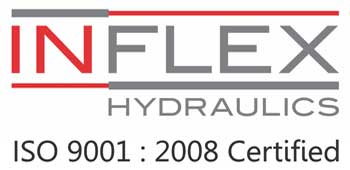STAMP it before you Spec it

The following is a list of factors which must be considered before final hose selection can be made:
- Pressure – After determining the system pressure, hose selection must be made so that the recommended maximum operating pressure is equal to or greater than the system pressure. Surge pressures higher than the maximum operating pressure will shorten hose life and must be taken into account by the hydraulic engineer.
- Suction – Hoses used for suction applications must be selected to ensure that the hose will withstand the vacuum and pressure of the system.
- Length – When establishing proper hose length; motion absorption, hose length changes due to pressure, as well as hose and machine tolerances must be considered.
- Temperature – Care must be taken to ensure that fluid and ambient temperatures, both static and transient, do not exceed the limitations of the hose. Special care must be taken when routing near hot objects such as manifolds.
- Fluid Compatibility – Hose selection must assure compatibility of the hose tube, cover, and fittings with the fluid used. Additional caution must be observed in hose selection for gaseous applications.
- Size – Transmission of power by means of pressurised fluid varies with pressure and rate of flow. The size of the components must be adequate to keep pressure losses to a minimum and avoid damage to the hose due to heat generation or excessive turbulence.
- Environment – Care must be taken to ensure that the hose and fittings are either compatible with, or protected from, the environment to which they are exposed. Environmental conditions such as ultraviolet light, ozone, salt water, chemicals and air pollutants can cause degradation and premature failure and, therefore, must be considered.
- Routing – Attention must be given to optimum routing to minimise inherent problems.
- Specifications and Standards – When selecting hose; government, industry, and manufacturer’s specifications and recommendations must be reviewed as applicable.
- Hose Cleanliness – Hose components vary in cleanliness levels. Care must be taken to ensure that the assemblies selected have an adequate level of cleanliness for the application.

- Electrical Conductivity – Certain applications require that hose be non-conductive to prevent electrical current flow. Other applications require the hose to be sufficiently conductive to drain off static electricity. Hose and fittings must be chosen with these needs in mind.
- High Pressure Gas – Do not use hydraulic hose to transmit high pressure gases.
- Mechanical Loads – External forces can significantly reduce hose life. Mechanical loads which must be considered include excessive flexing, twist, kinking, tensile or side loads, bend radius, and vibration. Use of swivel type fittings or adaptors may be required to ensure no twist is put into the hose. Unusual applications may require special testing prior to hose selection.
- Abrasion – While a hose is designed with a reasonable level of abrasion resistance, care must be taken to protect the hose from excessive abrasion which can result in erosion, snagging, and cutting of the hose cover. Exposure of the reinforcement will significantly accelerate hose failure.
- Proper End Fitting – Care must be taken to ensure proper compatibility exists between the hose and coupling selected based on the manufacturer’s recommendations substantiated by testing to industry standards such as SAE J517.
A similar way of doing this is the STAMPED process detailed here.

